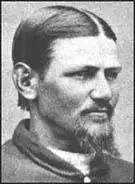Boston Corbett

Boston Corbett was born in England in 1832. When he was seven years old his family emigrated to the United States and settled in New York City. Corbett later moved to Troy where he worked as a hatter. He married but his wife died in childbirth.
After the death of his wife Corbett moved to Boston and found employment as a hatter. He became an evangelical Christian and began wearing his hair very long in the style of Jesus. To avoid the temptation of prostitutes, Corbett castrated himself with a pair of scissors.
On the outbreak of the American Civil War Corbett joined the Union Army and eventually reached the rank of sergeant in the 16th New York Cavalry. He was captured by the Confederate Army on 24th June, 1864, and was held captive at Andersonville Prison. He was eventually released and he returned to his unit.
When John Wilkes Booth shot Abraham Lincoln on 14th April, 1865, Corbett was one of the 26 cavalrymen in the party sent to capture him. They eventually caught up with Booth and David Herold at a barn owned by Richard Garrett. The federal troops had been ordered to take Booth and Herold alive. They were ordered to surrender but only Herold came out of the barn.
When Booth refused to surrender, the barn was set on fire. While this was happening, Corbett found a large crack in the barn and shot Booth. His body was dragged from the barn but he died a couple of hours later. Corbett was initially arrested for disobeying orders but on the instructions of Edwin M. Stanton, the Secretary of War, Corbett was released and eventually received his share of the reward money which amounted to $1,653.85.
After the war Corbett worked as a hatter in Connecticut and New Jersey. In 1878 he had a complete mental breakdown and lived in a dugout a few miles outside Concordia, Kansas.
Corbett was appointed assistant doorkeeper of the Kansas House of Representatives in Topeka. On 15th Febuary, 1887, he made an attempt to kill "heretics" in the legislature hall with a revolver. No one was hurt and after being arrested was declared insane and sent to the local asylum.
On 26th May, 1888, Boston Corbett escaped from the Topeka Asylum for the Insane. Except for a brief stay with Richard Thatcher, a man he had met while a prisoner at Andersonville during the Civil War, Corbett was never heard of again.
Primary Sources
(1) Boston Corbett, testimony before the Military Tribunal investigating the death of Abraham Lincoln (17th May, 1865)
After making inquiries at the house, it was found that Booth was in the barn. After being ordered to surrender, and told that the barn would be fired in five minutes if he did not do so, Booth made many replies. He wanted to know who we took him for; he said his leg was broken; and what did we want with him; and he was told that it made no difference. The parley lasted much longer than the time first set; probably a full half hour; but he positively declared that he would not surrender.
After a while we heard the whispering of another person - although Booth had previously declared that there was no one there but himself - who proved to be the prisoner Herold. Although we could not distinguish the words, Herold seemed to be trying to persuade Booth to surrender. Then Booth said, "Oh, go out and save yourself, my boy, if you can;" and then said, "I declare before my Maker that this man here is innocent of any crime whatever."
Immediately after Herold was taken out, the detective Mr. Conger, came round to the side of the barn where I was and set fire to hay through one of the cracks. In front of me was a large crack in the barn. I saw him make a movement toward the door. I supposed he was going to fight his way out. He was taking aim with the carbine. I took steady aim of my arm, and shot him through the large crack in the barn. He lived, I should think, until about 7 o'clock that morning; perhaps two or three hours after he was shot.
(2) Captain Edward Doherty, testimony before the Military Tribunal investigating the death of Abraham Lincoln (22nd May, 1865)
We requested Booth and Herold to come out of the barn. Herold eventually surrendered. I searched him and found a map of Virginia. Just at this time the shot was fired and the door thrown open, and I dragged Herold into the barn with me. Booth had fallen on his back. The soldiers went into the barn and carried out Booth. I took Herold and tied him by the hands to a tree opposite, about two yards from where Booth's body was carried, on the verandah of the house, and kept him there until we were ready to return. Booth in the mean time died.
(3) Robert Garrett, who witnessed the killing of John Wilkes Booth was interviewed by H. G. Howard in his book Civil War Echoes (1907)
Through the cracks could be seen the form of Booth standing in the middle of the building, supported by his crutch. In his hands he held a carbine. At this instant, Sergeant Corbett fired through a crack in the wall. He said afterward that Booth had a gun to his shoulder and was about to kill one of the officers. This is not so, as I was standing within six feet of Corbett when he fired the shot, and Booth never made a motion to shoot.

